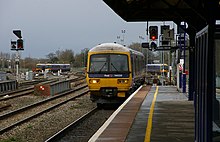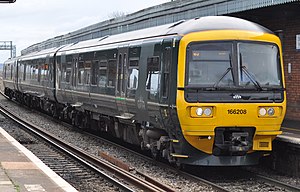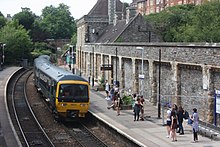BR class 166
| Class 166 | |
|---|---|
|
Great Western Railway 166208 on Didcot Parkway in 2015
|
|
| Numbering: | 166201-166221 |
| Number: | 21 triple units |
| Manufacturer: | ABB York |
| Year of construction (s): | 1992-1993 |
| Gauge : | 1435 mm ( standard gauge ) |
| Top speed: | 145 km / h |
| Motor type: | One per car, Perkins 2006-TWH |
| Motor type: | 14 liter 6 cylinder turbo diesel |
| Coupling type: | BSI |
The British Rail - Class 166 Networker Turbo is a fleet of diesel multiple units that were originally specified and built by British Rail, the then state rail operator in Great Britain . They were built by ABB at the York plant in 1992 and 1993. The trains were designed as a faster, air-conditioned variant of the Class 165 Turbo for long-distance traffic and, like the 165 , belong to the Networker train family. They were originally known as Networker Turbos to differentiate them from the electrically powered members of this family. Today, the 166s are usually referred to as the Thames turbos or just as turbos , alongside the 165s .
Class 166 vehicles are still in use today and, in addition to Class 165, are used for express lines from London Paddington and for local transport in Reading and Didcot Parkway. In July 2017, they began operations on the Severn Beach Line in Bristol to allow for the expansion of other services. Since September, they have been quickly introduced on other lines, e.g. B. on the Weston-super-Mare to Bristol Parkway route and on the Cardiff Central to Taunton route . They entered service on the Golden Valley Line in January 2018 and on the Heart of Wessex Line in February 2018. In addition, they have started operating some lines on the Wessex Main Line as far as Warminster and Southampton Central. They can also be found on branch lines in Greater London and Berkshire . As of March 2018, most of the Class 166 units are in service in Bristol and are stationed at St Philip's Marsh Depot.
description
These units are a modification of the Class 165 design. They have a top speed of 145 km / h (90 mph ) (suitable for long-distance travel), are carpeted throughout , and have air conditioning . Outwardly, class 166 can be distinguished from class 165 in that small tilt windows can be opened at every second window. Until the end of 2013, the presence of the first class on each end was another differentiator.
Other differences compared to a 165 are:
- Air conditioning
- Two toilets (a 165 has only one toilet per unit)
- Tables in the first class and in a third of the middle car
- Special bicycle / luggage storage in the middle car
- Different interior cladding between door and seating area
21 three-part units with the numbers 166201-221 were built. Each unit consists of two external drive motors and an intermediate motor. The technical description of the formation reads DMCO + MSO + DMSL. The individual cars are numbered as follows:
- 58101-58121 - DMCO
- 58601-58621 - MSO
- 58122–58142 - DMSL modified in 2013 by DMCO
The units were built to older diesel railcars of classes 117 , 119 and 121 as well as locomotive to replace hauled trains, from London Paddington on the Great Western Main Line wrong.
The original order was expanded to include six wagons in 1991 after Network SouthEast acquired some of the Cotswold Line services from Regional Railways to enable the conversion of Class 158 units to Class 159 units for the West of England line .
Class 166 vehicles are designed for pure driver operation. In cases where a train attendant is required, they have to perform their door operating tasks via a bell system to signal the drivers that the doors are closed and the train is starting. This requires the conductor to return to a vacant cab at each station to perform these duties; this practice can be seen on Great Western Railway services on the Cotswold Line and North Downs Line.
Your work in the Bristol area is slightly different. All journeys in the Bristol area have and will continue to have train attendants, so trains in the Bristol area are not just operated by the driver. The practice of opening and closing the doors is also different: the doors are released by the driver, but closed by the train attendant. All units now have local door panels attached to the doors of the end cars to allow the units to stop at stations with short platforms such as Avoncliff and Dilton Marsh. In these cases, the train attendant only releases his local door with these new panels, so that the train drivers do not release the doors at the stations with short platforms.
commitment

When these units were built, they were operated by the Thames Line and North Downs Line subdivisions of the SouthEast network.
Her main destinations included express trains to Reading , Newbury and Oxford , with some connections going beyond Oxford to Banbury and Stratford-upon-Avon or along the Cotswold Line to Evesham , Worcester , Great Malvern and Hereford . Units are also used on the connections from Reading Airport to Gatwick Airport along the North Downs Line. Many of the lines operated by the 166 were marked as Turbo Express in the timetables .
After the privatization, the units were transferred to the Thames Trains company. In April 2004 the operation of the Thames Trains was transferred to First Great Western Link and then to First Great Western .
In 2012, First Great Western took over five Adelante Class 180 units for Cotswold Line services and Sprinter Class 150 units with three cars for Reading-to-Basingstoke Line services, making the Class 165 and 166 units complete could be used for Thames Valley services.
As of July 2017, a number of turbos for services on the Severn Beach Line were relocated to Bristol to provide additional capacity during busy services. From October 2017, the 166 started on Weston-super-Mare to Bristol Parkway and Cardiff Central to Taunton. As more of the 166s moved to Bristol, they also began service on the Heart of Wessex Line and Golden Valley Line in 2018, replacing Class 150 units on those lines.
Refresher program
In late January 2010, First Great Western announced a £ 8 million refreshment program for its fleet of Class 166 multiple units . The carpets were relocated and seats reupholstered , the interiors repainted, the passenger information displays replaced by a Global Positioning System GPS- based system and the toilets upgraded. The refresher work was carried out at the Reading Depot. All 151 vehicles have now been renovated.
At the end of 2014, a further refresher course for class 166 began. This included the installation of LED headlights and taillights , new toilets that are more accessible than the old toilets, new door buzzers and new door knobs in the standard design with a round button on a yellow ring. All units have now received the refresher. Unit 166204 was named in honor of the Twyford station master, Norman Topsom MBE, who retired in November 2015. The changes made during the 2010 refresh remain in place, however, once the fleet has been cascaded into the Bristol area, all units will receive new 2 + 2 seating for use on longer routes such as Bristol – Weymouth.
Fleet details
| class | operator | number | Built | Cars per association | Unit number |
|---|---|---|---|---|---|
| Class 166/2 | Great Western Railway | 21st | 1992-1993 | 3 | 166201-166221 |
Paintwork and interiors
Web links
Individual evidence
- ^ London to the Cotswolds, Worcester and Hereford. November 27, 2012, accessed June 25, 2020 .
- ↑ Additional carrages will be added to FGW trains. March 25, 2015, accessed June 25, 2020 .
- ↑ Turbo-trains (Hansard, June 6, 1991). Retrieved June 25, 2020 .
- ↑ Class 159. Retrieved June 25, 2020 .
- ↑ Return of Adelantes to First Great Western confirmed | Railnews | Today's news for Tomorrow's railway. Retrieved June 26, 2020 .
- ↑ Predicted snowfall. February 27, 2019, accessed June 26, 2020 .
- ↑ First Great Western - Train operator gives Thames Valley Trains an £ 8million makeover. June 11, 2011, accessed June 26, 2020 .










